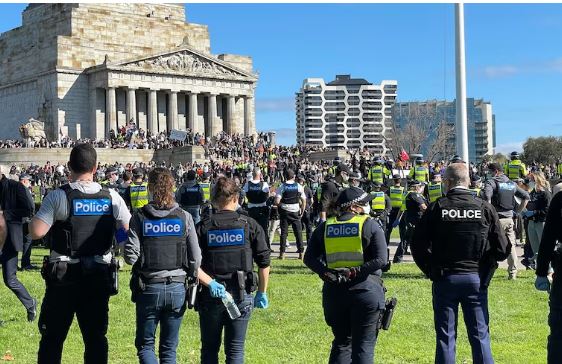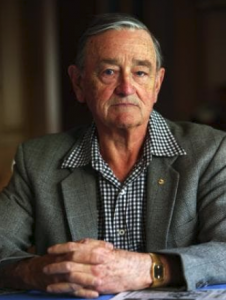
by CAA | Feb 5, 2025 | Library, Media, Politics, Victoria Police Issues
Victoria can be forgiven for collectively exercising a sigh of relief at the announcement by the Allan Government about Bail Laws, Herald Sun 4th February 2025, but relief may well be premature until we see the new plans because we are not hopeful that the Government has seen the light and is proffering a solution to the worst crime rate in Victoria’s history and this may not be the silver bullet of Victoria’s hope.
The government only appears to view the problems through a narrow prism which will not lead to solutions that altering the Bail Laws is promoted to achieve.
We are not confident because the Premier has called an ‘immediate review’. Yes, that is the get-out-of-jail card so often brandished by politicians in a corner.
Pardon our scepticism, but we have seen all this before. No meaningful outcome will be achieved as the people called upon to conduct this review are the same people who advised the government on the ‘New’ crime laws passed into legislation less than six months ago that achieved little if any positive impact; at least, there is no noticeable change in the way the Courts or Police are operating that is visible.
The probability is not high that a new review by the same people and departments will expose how they got it all wrong last time.
What will happen is that the review outcome will exonerate the previous architects; the new review will see to it.
The irony is that the Premier does not even recognise the problem she is supposed to be dealing with.
There is no argument from us that the Bail Laws must be tightened, as must the judiciary’s discretion, as they will find ways to bypass possible changes to the Law.
And yes, if this is done correctly, we will see an improvement in the Law-and-Order space, but we cannot be complacent, as the crime issue will not be addressed by one magic (or not-so-magic) bullet.
All the changes in the Bail Laws may be thwarted by the judiciary, who have all seemingly overindulged in the Restorative Justice cool-aid.
The review must include how the independence of the judiciary can be retained while complying with any new strategies introduced.
Judicial accountability would be a good start.
Of equal importance is an understanding that crime prevention is the most cost-effective strategy to reduce crime. Stopping crimes happening first rather than dealing with the miscreants after they commit crimes makes absolute sense, but that does not sit well with some ideological advocates.
Seen often as the soft option, in Police parlance, Proactive policing is the only strategy shown to work.
The power of police foot patrols interacting with the community regularly is one of the most underrated weapons in the Police arsenal, but Victoria Police would instead put resources into the plethora of Task Forces and any other groups that are targeted at a particular crime after the event. We believe there are literally thousands of Police tied up in special target groups at a State and local level.
There will always be a need for some Task Force groups. Still, VicPol has become so addicted to them that they see no other alternative strategy, and there is no evidence that the Task Force approach actually works. With a rising crime rate, it is highly improbable they have any impact on the overall crime, only spasmodic impact on particular offenders who immediately get bail anyway, so the Police Task Force has been a waste of time.
Victoria has proven beyond any shadow of a doubt that recently developed strategies in combination promote /facilitate crime, not reduce it.
As we have pointed out previously, children do not enter this world with an ingrained criminal disposition; all criminal values are taught, so early intervention in a child’s development is critical, and the formative Primary School Years are the logical target area if a difference is to be achieved.
If a large percentage of police resources dedicated to Task Forces were redirected to early intervention, we would see a dramatic decline in crime.
Police performing their proper function would also see the Force attracting more recruits and retaining those they have.
The Premier would do well to ask the community what strategy they would prefer.
After all, they have to live with the consequences of whatever is implemented- this review must focus on Service Delivery as their guiding principle.

by CAA | Jan 8, 2025 | Investigations, Library, Media, Politics, Road Safety, Victoria Police Issues
A 67-year-old male driver lost his life when his small car was destroyed by a speeding truck.
The truck was allegedly stolen, and Police had failed to stop it using ‘stop sticks’.
Apart from the ‘stop sticks’ being old problematic technology, we need to look further as to why this life was wasted and what systematic failures contributed to the death.
The ability of police to intercept dangerous vehicles safely must be addressed, and new technologies capable of stopping a vehicle must be legitimately explored.
The CAA has long advocated for the introduction of the G-Tag (see https://caainc.org.au/the-g-tag-a-new-…community-safety/) to give Police the ability to disable a vehicle that poses an unacceptable threat to the occupants or the public more generally. Additionally, it will also reduce the danger to the police themselves, and that has to be a significant positive.
This technology will also play a critical role in any upsurge in terrorism.
Of equal importance, the circumstances of this crash and waste of life can be put squarely on the shoulders of the judiciary. Not the government but the judiciary.
It was reported that,
“A 40-year-old Deer Park man, who police allege was driving the truck, was taken to hospital with non-life-threatening injuries.
It was later revealed he was on bail for previous car theft and drug possession crimes and was due to face court in February after police charged him with another car theft, unlicensed driving and possessing drugs in November.”
If this life lost is not to be in vain, the establishment of nothing less than a Royal Commission to examine the role of the judiciary in these matters is well justified.
The accountability of the Judiciary is the point to be questioned, noting that in the lower courts, and in particular bail hearings, the presiding judicial officer is never named by the media. In contrast, the higher court Judges are regularly named as a matter of course. A legitimate form of accountability is lacking in the lower jurisdictions.
This lack of accountability, where the presiding officers can remain anonymous, must change so the public can know which judiciary members are responsible for bad outcomes.
The judiciary generally seems to hide behind the government, claiming they are only working within the laws the government provides. This is nonsense.
They must interpret the laws relevant to the circumstances of the matters before them.
An inquiry would expose the folly of the infection of the judiciary by the failed theoretical strategy called ‘Restorative Justice’ and given the regular failure of courts to hold perpetrators to account and protect the public, that infection has reached epidemic proportions, and people are dying as a result.
The pendulum has swung too far in favour of the criminals, and the rest of the community is indeed paying a very high price – with their lives.
The CAA invites the Government and the Opposition to urgently meet with the CAA to explore the G-Tag issue.
It is now a matter of life and death.

by CAA | Feb 7, 2024 | Current, Library, Media, Politics
To see police involved in a fracas at the recent Pride march is deplorable. This outcome was inevitable, and police should never have put themselves in this position.
Irrespective of who was the instigator of the melee, the Police, instead of performing the police function to solve a social problem, were part of it.
The seeds for this outcome were sown some twenty years ago when the Police moved from policing the event to being part of it.
The CAA logo features Lady Justice, who is depicted as blindfolded, showing Justice is blind.
The meaning is profound and forms the basis of our Justice system, which includes the Police.
Police must never become part of the issue and remain independent to exercise their powers in a dispassionate way, not showing favouritism or bias to the problems they are policing.
Being part of this march destroys impartiality and undermines the fundamental role of the Police.
We also noticed Police uniforms adorned in trinkets supporting the pride genera. These displays, supporting a particular cause, would be irreverent to many and detract from the impartiality that Police should project and preserve.
These displays must not be worn on uniforms or, for that matter, any clothing while a police member is on duty. It is a matter of professional pride.
It also could be argued that this police activity is in breach of their Oath of Office.
…that I will well and truly serve our Sovereign as a police officer in Victoria in any capacity in which I may be appointed, promoted, or reduced to, without favour or affection, malice or ill-will for the period of [ insert period ] from this date, and until I am legally discharged, that I will see and cause the peace to be kept and preserved, and that I will prevent to the best of my power all offences, and that while I continue to be a police officer I will to the best of my skill and knowledge discharge all the duties legally imposed on me faithfully and according to law.
This issue has nothing to do with the personal preferences exercised by any member of the Force in their private lives. That is their business, and if they want to march, they have every right to participate, just not in uniform.
In many ways, this clash was inevitable.
According to reports, there has been anti-police sentiment for a long time, and leadership should have been taken to avoid the inevitable confrontation.
In this event, participants dress up gregariously, as is their right; however, by high-level participation by the Police, they are relegating the uniform to fancy dress.
There are always huge risks when police favour one particular group, and we are confident that the Police Command would not tolerate uniformed Police marching in solidarity with Black Lives Matter, anti-COVID, Union movement, anti-government, environmental or the myriad of other special interest groups.
The test may again come as those who support Palestine become more vociferously anti-Israel as that war drags on.
Police, like all Australians, are entitled to exercise their right to lawful assembly, just not in uniform.
We encourage Victoria Police, in the interest of fair justice for all, to issue a direction that police on or off duty cannot participate in any demonstrations or cause in uniform.
Demonstrating a bias for or against any particular interest group is counterintuitive to effective policing.

by CAA | Dec 3, 2023 | Library, Media, Politics, Victoria Police Issues
The breaking down of law and order in Victoria has been evident for some time, but recently, this concept has accelerated to a very worrying level.
The past is only relevant to identify patterns; the future is the worry, as it seems nothing is being done to arrest the decline.
Currently, the situation where demonstrators, seemingly with impunity, do whatever they can to intimidate another sector of the community, instilling gross fear on any part of the community, is unacceptable on so many levels.
Worryingly, is that the intimidation is so vitriolic it is only a ‘hair’s breadth’ away from violence.
The seriousness of the situation cannot be downplayed, and yet the Police, who are responsible for maintaining law and order, seem ineffective through bias.
This is not the Australian way.
The bias by Policing has been developing for some time, and we suggest it has a lot to do with the failure of the principle of the ‘Separation of Powers’[i], a long-held presumption that has been eroded, and the management of public order is where it most obviously manifests.
The failure of this principle, where the decisions and responses to public order are tainted by Political bias, is a two-way street.
The blatant direct involvement of politics in decision-making has become far less obvious, but we are sure it still occurs; what has evolved is a far more insidious, unconscious bias. A will to please political masters or those who support the government without direct interaction.
The Police have no role in allowing partisan views to influence responses but must respond on the basis of maintaining law and order, and that includes protecting vulnerable groups and all citizens; the issues and reasons for disquiet must never influence the operational response.
Some of the disquiet in police ranks that has provoked industrial action recently has been attributed to the Forces’ obvious bias.
This move toward partisanship with the government of the day has been an attempt by Governments to own police powers and have a far greater say in the operations of Policing, a repugnant concept that might seem fine in theory, but, as we have seen, makes Policing ineffective.
The current demonstrations against Israel by pro-Palestinian groups supporting Hamas are a case in point.
The basis of the demonstrations is those allegedly opposed to Israel’s response to the attacks, hostage-taking and murders committed by Hamas. The role of Victoria Police must not be influenced by the reasons for the demonstration but by providing a Police response to maintain Law and order and should be as concerned with protecting the abused Jews as they should be for those who identify as Pro-Palestinian.
The accusation of police bias is a ‘hot button’ issue sure to raise the ire of Police executives. Be that as it may, the matter is immensely serious, and the issue of the breakdown of the ‘Separation of Powers’ and biase must be corrected.
To ignore the issue will be a blight on the capacity of Police Senior management as this issue lies at their feet.
The following list of incidents indicates beyond doubt that bias is at play and must be addressed.
- Black Lives Matter – passive police response acting as spectators.
- COVID-19 – aggressive police response including use of firearms on demonstrators – aggressive role extending over numerous occasions for two years, including chasing and dispersing demonstrators using defensive weapons like pepper spray as an attack weapon. Tea bagging protestors to make them breach the COVID rules.
- Sundry environmental demonstrations – passive police role acting as spectators.
- Pro-Palestine (Hamas) demonstrations -passive police response acting as spectators.
We do not support unnecessarily aggressive responses but demand the Police apply the law without fear or favour, malice or ill will, absolutely, irrespective of the issue at hand.
Following this principle will rapidly improve and rebuild the image and confidence that the community had in its Police, and the police members will be able to return to the non-partisan positions they once were able to hold in their professional capacity, improving the morale within the organisation so that the workplace again becomes non-partisan.
We acknowledge, however, that the government has a lot to answer for by diluting the Police power to manage these issues by repealing the ‘move on’ Laws.
It has seriously diminished police authority to perform their task.
By removing those powers, the closest analogy is a law to remove the ability of doctors to carry a stethoscope when working in Emergency Rooms (ER).
The Victoria Police can and must do better operationally, free from Government pressure and interference.
[i] In Australia, the power to make and manage laws is shared between the Parliament, the Executive and the Judiciary. The separation of powers avoids any person or group having all the power. https://peo.gov.au/
by CAA | Dec 29, 2019 | Library, Media, Uncategorized
A video presentation of the launch of the Police Veterans in Schools Program produced by Board member Frank Caridi is presented for those that were unable to attend.
![PVISP Newsletter]()
by CAA | Dec 17, 2019 | Library, Media, Uncategorized

Welcome to the first edition of the Community Advocacy Alliance, Police Veterans in Schools Newsletter.
Chairman’s Message 
This first Police Veterans in Schools Newsletter is an historic moment in the life of The Community Advocacy Alliance Inc’s history following our successful launch of the Program on 23 November 2019.
I acknowledge the enormous amount of work done by all concerned with special thanks to our CEO, Ivan Ray.
The need for police to have good relationships with young people, particularly before they become offenders, is so blatantly obvious that it is difficult to understand what is holding the Victoria Police back from becoming totally involved. After all, it is clear current policing practices have failed miserably in preventing youth crime.
Using the successful Police in Schools Program introduced to Victoria in 1989 as a guide, it is obvious that the PVISP will have a significant impact in keeping many young people out of trouble to the benefit of the community at large. The workload of overworked rank and file police can only diminish as a result.
I am extremely confident that our PVISP will go from strength to strength.
The agreement of former Member, Ron Fenton, to act as our roving Ambassador and adopting his ‘service dog, Yogi’ as our Mascot is a reminder of the danger of police service and I thank Ron for his involvement.
My message to the Government and the Victoria Police is to take your collective heads out of the sand and get involved. Young people deserve help, and the community demands more significant action to curb youth crime and anti-social behaviour.
I thank all members of the CAA Board and all our supporters for their enthusiastic support.
Merry Christmas and a safe and Happy New Year to all.
Kelvin (Kel) Glare AO APM
CAA Chair
PVISP Launch
After the recent successful launch at the Box Hill RSL on Saturday the 23rd of November,
we are now hard at work going through the initial phase of linking Veterans to their schools. Rita Panahi was our guest of honour tasked with officially launching our program. Over sixty invited guests joined veteran volunteers and the CAA Board at the event where the program was laid out for all. Rita expressed her amazement that this task should fall to the retired Police who were receiving no official support practical or otherwise. Rita emphasised the point that the program was a ‘No Brainer’ and she was astounded at the response from Vitoria Police as it defied logic. She also referred to, the fact that should not be overlooked, that Retired Police were so motivated by current in-action they felt it necessary to step up, and that says it all.
New Mascot 
Yogi and Ron have become our mascot and Ambassador, you can work out which is which. Ron a Police Veteran severally injured in the line of duty protecting Victorians, who to this day suffers as a result of being shot in the head by a deranged criminal, has Yogi as his guardian angel. Yogi is trained to warn Ron when difficulties start to manifest and he has improved Ron’s quality of life dramatically. Ron still carries shrapnel that cannot be removed from his head and has suffered the consequences of the damage by those fragments. The damage done by the bullet has required Ron to learn to walk and talk again and regain mobility a challenge in its self. Medicine has done as much as it can for Ron but it has been Yogi that has provided the missing link.
Ron will be visiting schools and introducing Yogi to the children in support of the schools Veteran Officers. We are confident that Yogi will embrace his new role and acquit himself with his new skill of breaking down barriers with young people. Incidentally, having a real live Police hero in the classroom may also help.
School Expressions of interest
*All schools should have a Veteran allocated by the start of the school year
*Additional schools are currently under consideration
| School |
Veteran |
| Camberwell Primary School |
TBA |
| Cheltenham College |
TBA |
| Bannockburn P12 |
TBA |
| Stenevsville Primary School |
Ross Whittingham |
| St Leonards College |
TBA |
| Karingal Primary School |
TBA |
| Wallan Primary School |
Roger Sanders |
| St Francis Xavier College |
TBA |
| Kerrimuir Primary School |
TBA |
| |
|
| |
|
| |
|

by CAA | Nov 9, 2019 | Library, Media, Uncategorized
10th of November’19
Popular Herald Sun journalist and Sky News presenter Rita Panahi will be launching the Police Veterans In Schools Program (PVISP) later this month. Rita with a reputation of, telling it like it is, is a natural fit for the Community Advocacy Alliance (CAA) who are equally committed to, telling it like it is, albeit, like Rita, we are not appreciated in some quarters.
The proposal for a PVISP program is already attracting retired Police Veteran volunteers who understand the importance of educating children on the role of police and how to deal with the social challenges they face.
With the many years of police service, the veterans have experience many current serving Police member have yet to gain, so are brilliantly equipped to educate and provide guidance for our young Victorians.
The program has also attracted a number of schools who are very enthusiastic about having a PVISP Veteran join their school community. Already local government is pushing to have the program introduced in their municipality so the growth of the program is ensured.
As the inquiry level increases, the CAA is gearing up for the increased demand both from the schools, and the Police Veterans wanting to participate.
by CAA | Mar 20, 2019 | Media, Uncategorized
by CAA | Mar 12, 2019 | Media
by CAA | Mar 10, 2019 | Media, Uncategorized
by CAA | Feb 20, 2019 | Media, Uncategorized
by CAA | Feb 14, 2019 | Media
by CAA | Jan 20, 2019 | Media










